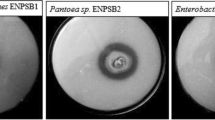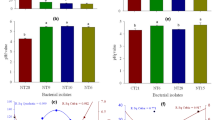Abstract
Phosphate-solubilizing bacteria (PSB) are microorganisms that can dissolve insoluble phosphorus (P) to accessible forms. This study aimed to screen saline–alkali-tolerant PSB and analyze its growth promoting properties, and evaluate its effects on the growth, quality, soil nutrient balance, and enzyme activities of silage maize in the field. We isolated six phosphate-solubilizing strains from rhizosphere soil of silage maize planted in saline–alkali land, and FC-1 with the best P-solubilizing effect was used for further study. The morphological, physiological and biochemical analysis, and 16S rDNA and housekeeping gene atpD sequencing were performed for identification. FC-1 was identified as Pantoea dispersa and had high P solubility. The phosphate solubility of FC-1 using four P sources ranged from 160.79 to 270.22 mg l−1. FC-1 produced indole-3-acetic acid (IAA) and decreased the pH of the growth media by secreting organic acids, including citric acid, malic acid, succinic acid, and acetic acid. The results of a field experiment indicated that FC-1 treatment increased the height, stem diameter, fresh weight, dry weight, starch content, crude protein content, and total P content of silage maize by 9.8, 9.2, 12.6, 11.7, 12.6, 18.3, and 17.4%, respectively. The nitrogen, potassium, phosphorus, and organic matter contents in the rhizosphere soil of silage maize increased by 29.8, 17.1, 17.9, and 25.3%, respectively; urease, catalase, sucrase, and alkaline phosphatase levels also increased by 24.7, 26.7, 24.0, and 19.5%, respectively. FC-1 promoted the growth of silage maize by improving nutrient metabolism and enzyme activities in saline–alkali soil and may be an effective alternative to fertilizers.





Similar content being viewed by others
Availability of Data and Material
The datasets generated during and/or analyzed during the current study are available from the corresponding author on reasonable request.
Code Availability
Not applicable.
References
Li YB, Liu XM, Hao TY, Chen SF (2017) Colonization and maize growth promotion induced by phosphate solubilizing bacterial isolate. Int J Mol Sci 18(07):562–578. https://doi.org/10.3390/ijms18071253
Li YF, Li GH (2022) Mechanisms of straw biochar’s improvement of phosphorus bioavailability in soda saline-alkali soil. Environ Sci Pollut Res Int 29(32):47867–47872. https://doi.org/10.1007/s11356-022-20489-3
Rezakhani L, Motesharezadeh B, Tehrani MM, Etesami H, Hosseini HM (2019) Phosphate-solubilizing bacteria and silicon synergistically augment phosphorus (P) uptake by wheat (Triticum aestivum L.) plant fertilized with soluble or insoluble P source. Ecotoxicol Environ Saf 173:504–513. https://doi.org/10.1016/j.ecoenv.2019.02.060
Gyaneshwar P, Kumar GN, Parekh LJ, Poole PS (2002) Role of soil microorganisms in improving P nutrition of plants. In: Adu-Gyamfi JJ (ed) Food security in nutrient-stressed environments: exploiting plants’ genetic capabilities. Springer, Dordrecht, pp 133–143
Wang HW, Li K, Hu XJ, Liu ZF, Wu YJ, Huang CL (2016) Genome-wide association analysis of forage quality in maize mature stalk. BMC Plant Biol 16(1):227. https://doi.org/10.1186/s12870-016-0919-9
Rohman MM, Islam MR, Monsur MB, Amiruzzaman M, Fujita M, Hasanuzzaman M (2019) Trehalose protects maize plants from salt stress and phosphorus deficiency. Plants 8(12):568. https://doi.org/10.3390/plants8120568
Jiang HH, Qi PS, Wang T, Wang M, Chen MN, Chen N, Pan LJ, Chi XY (2018) Isolation and characterization of halotolerant phosphate-solubilizing microorganisms from saline soils. 3 Biotech 8(11):461. https://doi.org/10.1007/s13205-018-1485-7
Manzoor M, Abbasi MK, Sultan T (2016) Isolation of phosphate solubilizing bacteria from maize rhizosphere and their potential for rock phosphate solubilization-mineralization and plant growth promotion. Geomicrobiol J 34(01):81–95. https://doi.org/10.1080/01490451.2016.1146373
Rodríguez H, Fraga R (1999) Phosphate solubilizing bacteria and their role in plant growth promotion. Biotechnol Adv. 17(4–5):319–339. https://doi.org/10.1016/s0734-9750(99)00014-2
Wei YQ, Zhao Y, Shi MZ, Cao ZY, Lu Q, Yang TX, Fan YY, Wei ZM (2018) Effect of organic acids production and bacterial community on the possible mechanism of phosphorus solubilization during composting with enriched phosphate-solubilizing bacteria inoculation. Bioresource Technol 247:190–199. https://doi.org/10.1016/j.biortech.2017.09.092
Xie JG, Yan ZQ, Wang GF, Xue WZ, Li C, Chen XW, Chen DF (2021) A bacterium isolated from soil in a karst rocky desertification region has efficient phosphate-solubilizing and plant growth-promoting ability. Front Microbiol 11:625450. https://doi.org/10.3389/fmicb.2020.625450
Qiao H, Sun XR, Wu XQ, Li GE, Wang Z, Li DW (2019) The phosphate-solubilizing ability of Penicillium guanacastense and its effects on the growth of Pinus massoniana in phosphate-limiting conditions. Biol Open 8(11):bio046797. https://doi.org/10.1242/bio.046797
Chen Q, Liu SJ (2019) Identification and characterization of the phosphate-solubilizing bacterium Pantoea sp. S32 in Reclamation Soil in Shanxi, China. Front Microbiol 10:2171
Jin FY, Hu QL, Zhao YX, Lin XY, Zhang JF, Zhang JJ (2022) Enhancing quinoa growth under severe saline-alkali stress by phosphate solubilizing microorganism Penicillium funicuiosum P1. PLoS One 17(9):e0273459
Gupta R, Singal R, Shankar A, Kuhad RC, Saxena RK (1994) A modified plate assay for screening phosphate solubilizing microorganisms. J Gen Appl Microbiol 40(3):255–260. https://doi.org/10.2323/jgam.40.255
Nautiyal CS (1999) An efficient microbiological growth medium for screening phosphate solubilizing microorganisms. FEMS Microbiol Lett 170(1):265–270. https://doi.org/10.1111/j.1574-6968.1999.tb13383.x
Zhang XS (2008) Analysis of the factors affecting the available P content in the fermentation liquid of P bacteria determined by mo-sb colorimetry. J Anhui Agric Sci 12:4822–4823. https://doi.org/10.1016/S1872-2067(08)60059-5. (in Chinese)
Kozaki M, Uchimura T, Okada S (1992) Experimental manual of lactic acid bacteria. Asakurasyoten, Tokyo
Buchanan RE, Gibbons NE (1984) Bergeys manual of systematic bacteriology. Science Press, Beijing
Brady C, Cleenwerck I, Venter S, Vancanneyt M, Swings J, Coutinho T (2008) Phylogeny and identification of Pantoea species associated with plants, humans and the natural environment based on multilocus sequence analysis (MLSA). Syst Appl Microbiol 31(6–8):447–460. https://doi.org/10.1016/j.syapm.2008.09.004
Glickmann E, Dessaux Y (1995) A critical-examination of the specificity of the Salkowski reagent for indolic compounds produced by phytopathogenic bacteria. Appl Environ Microbiol 61(2):793–796. https://doi.org/10.1128/aem.61.2.793-796.1995
Guan SY (1986) Soil enzyme and its research methods. China Agriculture Press, Beijing
Bao SD (2005) Soil and agricultural chemistry analysis. China Agriculture Press, Beijing
AOAC (2000) Official methods of analysis of AOAC International, 17th edn. Association of Official Analytical Chemists, Gaithersburg, MD
Cavell AJ (2010) The colorimetric determination of phosphorus in plant materials. J Sci Food Agr 6(8):479–480. https://doi.org/10.1002/jsfa.2740060814
Enebe MC, Babalola OO (2018) The influence of plant growth-promoting rhizobacteria in plant tolerance to abiotic stress: a survival strategy. Appl Microbiol Biot 102(18):7821–7835. https://doi.org/10.1007/s00253-018-9214-z
Teng ZD, Chen ZP, Zhang Q, Yao Y, Song MY, Li M (2019) Isolation and characterization of phosphate solubilizing bacteria from rhizosphere soils of the Yeyahu Wetland in Beijing, China. Environ Sci Pollut Res Int 26:33976–33987. https://doi.org/10.1007/s11356-018-2955-5
Joshi S, Gangola S, Jaggi V, Sahgal M (2023) Functional characterization and molecular fingerprinting of potential phosphate solubilizing bacterial candidates from Shisham rhizosphere. Sci Reports 13(1):7003. https://doi.org/10.1038/s41598-023-33217-9
Bautista-Cruz A, Antonio-Revuelta B, Gallegos VDCM, Báez-Pérez A (2019) Phosphate-solubilizing bacteria improve Agave angustifolia Haw. growth under field conditions. J Sci Food Agr 99(14):6601–6607. https://doi.org/10.1002/jsfa.9946
Peng LY, Yi T, Song XP, Liu H, Yang HJ, Huang JG (2021) Mobilization of recalcitrant phosphorous and enhancement of pepper P uptake and yield by a new biocontrol and bioremediation bacterium Burkholderia cepacia CQ18. J Appl Microbiol 130(6):1935–1948. https://doi.org/10.1111/jam.14844
Bashan Y, Kamnev AA, de-Bashan LE (2013) Tricalcium phosphate is inappropriate as a universal selection factor for isolating and testing phosphate-solubilizing bacteria that enhance plant growth: a proposal for an alternative procedure. Biol Fert Soils 49(4):465–479. https://doi.org/10.1007/s00374-012-0737-7
Paul D, Nair S (2008) Stress adaptations in a plant growth promoting rhizobacterium (PGPR) with increasing salinity in the coastal agricultural soils. J Basic Microb 48(5):378–384. https://doi.org/10.1002/jobm.200700365
Zhang H, Han LZ, Jiang B, Long CM (2021) Identification of a phosphorus-solubilizing Tsukamurella tyrosinosolvens strain and its effect on the bacterial diversity of the rhizosphere soil of peanuts growth-promoting. World J Microb Biot 37(7):109. https://doi.org/10.1007/s11274-021-03078-3
Selvakumar G, Kundu S, Joshi P, Nazim S, Gupta AD, Mishra PK, Gupta HS (2008) Characterization of a cold-tolerant plant growth-promoting bacterium Pantoea dispersa 1A isolated from a sub-alpine soil in the North Western Indian Himalayas. World J Microb Biot 24:955–960. https://doi.org/10.1007/s11274-007-9558-5
Ibáñez A, Diez-Galán A, Cobos R, Calvo-Peña C, Barreiro C, Medina-Turienzo J, Sánchez-García M, Coque JJR (2021) Using rhizosphere phosphate solubilizing bacteria to improve barley (Hordeum vulgare) plant productivity. Microorganisms 9(8):1619. https://doi.org/10.3390/microorganisms9081619
Mehta P, Walia A, Kulshrestha S, Chauhan A, Shirkot CK (2015) Efficiency of plant growth-promoting P-solubilizg Bacillus circulans CB7 for enhancement of tomato growth under net house conditions. J Basic Microb 55(01):33–44. https://doi.org/10.1002/jobm.201300562
Paungfoo-Lonhienne C, Lonhienne TGA, Yeoh YK, Webb RI, Lakshmanan P, Chan CX, Lim PE, Ragan MA, Schmidt S, Hugenholtz P (2014) A new species of Burkholderia isolated from sugarcane roots promotes plant growth. Microb Biotechnol 7(02):142–154. https://doi.org/10.1111/1751-7915.12105
Prakash J, Arora NK (2019) Phosphate-solubilizing Bacillus sp. enhances growth, phosphorus uptake and oil yield of Mentha arvensis L. 3 Biotech 9(4):126. https://doi.org/10.1007/s13205-019-1660-5
Sarikhani MR, Khoshru B, Greiner R (2019) Isolation and identification of temperature tolerant phosphate solubilizing bacteria as a potential microbial fertilizer. World J Microb Biot 35(08):126–136. https://doi.org/10.1007/s11274-019-2702-1
Kaur G, Reddy MS (2013) Phosphate solubilizing rhizobacteria from an organic farm and their influence on the growth and yield of maize (Zea mays L.). J Gen Appl Microbiol. 59(04):295–303. https://doi.org/10.2323/jgam.59.295
Mohammadi K, Heidari G, Karimi Nezhad MT, Ghamari S, Sohrabi Y (2012) Contrasting soil microbial responses to fertilization and tillage systems in canola rhizosphere. Saudi J Biol Sci 19(3):377–383. https://doi.org/10.1016/j.sjbs.2012.05.001
Zhang Y, Lang LN, Sun ZX, Li MT (2023) Potential application of Paenibacillus sp. C1 to the amelioration of soda saline-alkaline soil. Geomicrobiol J. 40(2):172–182. https://doi.org/10.1080/01490451.2022.2137601
Sharma SB, Sayyed RZ, Trivedi MH, Gobi TA (2013) Phosphate solubilizing microbes: sustainable approach for managing phosphorus deficiency in agricultural soils. SpringerPlus 2:587. https://doi.org/10.1186/2193-1801-2-587
Zaidi A, Khan MS, Ahemad M, Oves M, Wani PA (2009) Recent advances in plant growth promotion by phosphate-solubilizing microbes. In: Khan M, Zaidi A, Musarrat J (eds) Microbial strategies for crop improvement. Springer, Berlin
Azaroual SE, Hazzoumi Z, Mernissi NEI, Aasfar A, Kadmiri IM, Bouizgarne B (2020) Role of inorganic phosphate solubilizing bacilli isolated from moroccan phosphate rock mine and rhizosphere soils in wheat (Triticum aestivum L.) phosphorus uptake. Curr Microbiol 77(9):2391–2404. https://doi.org/10.1007/s00284-020-02046-8
Funding
This work was supported by the Key Scientific and Technological Project of Heilongjiang Province of China (2021ZXJ03B05), the Climbing project of China College Students' Entrepreneurship Competition, and the Graduate Innovation Fund of Harbin Normal University (HSDSSCX2021-05).
Author information
Authors and Affiliations
Contributions
Dan Wang and Changhong Guo: Study conceptualization and design. Changhong Guo: Provision of reagents/materials/analysis tools. Ying Cui, Yujie Zhao, Run Cai, Hao Zhou, and Jiaxin Chen: Experiment. Ying Cui, Yujie Zhao, Hao Zhou, Jiaxin Chen, and Lirong Feng: Data analysis. Dan Wang and Yujie Zhao: Manuscript writing. Dan Wang and Changhong Guo: Manuscript revision. All authors read and approved the final manuscript.
Corresponding authors
Ethics declarations
Conflict of Interest
The authors declare no relevant financial or non-financial interests to disclose.
Ethics Approval
Our study does not involve human and animal subjects, without ethical problem. This study conforms to the ethical and moral require.
Consent to Participate
All the authors of this article were consented.
Consent for Publication
Written informed consent for publication was obtained from all authors. This study was consented to be published.
Additional information
Publisher's Note
Springer Nature remains neutral with regard to jurisdictional claims in published maps and institutional affiliations.
Supplementary Information
Below is the link to the electronic supplementary material.
Rights and permissions
Springer Nature or its licensor (e.g. a society or other partner) holds exclusive rights to this article under a publishing agreement with the author(s) or other rightsholder(s); author self-archiving of the accepted manuscript version of this article is solely governed by the terms of such publishing agreement and applicable law.
About this article
Cite this article
Cui, Y., Zhao, Y., Cai, R. et al. Isolation and Identification of a Phosphate-Solubilizing Pantoea dispersa with a Saline–Alkali Tolerance and Analysis of Its Growth-Promoting Effects on Silage Maize Under Saline–Alkali Field Conditions. Curr Microbiol 80, 291 (2023). https://doi.org/10.1007/s00284-023-03408-8
Received:
Accepted:
Published:
DOI: https://doi.org/10.1007/s00284-023-03408-8




